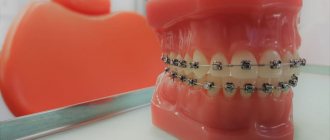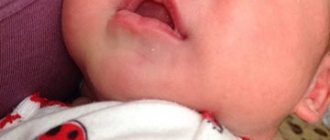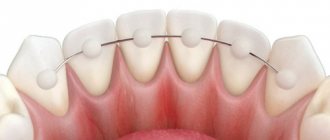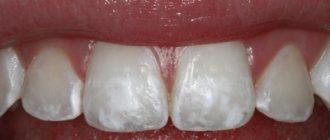Author of the article:
Soldatova Lyudmila Nikolaevna
Candidate of Medical Sciences, Professor of the Department of Clinical Dentistry of the St. Petersburg Medical and Social Institute, Chief Physician of the Alfa-Dent Dental Clinic, St. Petersburg
Let's figure out what complications exist when wearing braces and the consequences of such a long-term smile correction, and most importantly, how to avoid or minimize them.
Possible complications when wearing structures
As a rule, the orthodontist informs the patient about all the consequences that may occur due to the new system in the oral cavity before starting treatment. Many difficulties are normal for the adaptation period, however, some pathologies require specialist intervention.
The most common problems associated with wearing braces are:
- Sensation of a foreign body in the oral cavity.
A new device in your mouth will inevitably cause discomfort. However, over time, the owner of the system adapts to the new sensations and ceases to feel the braces. Typically, the adaptation period lasts 1-2 weeks after installation. - Pain in the periodontal area.
Unpleasant sensations in some areas of the gums are considered normal. Under pressure, the teeth gradually move into the correct position, which causes pain. This symptom does not appear in all patients and depends, first of all, on the severity of the defect. If the discomfort intensifies, dentists recommend taking a pain reliever. - Headache.
Surprisingly, when wearing orthopedic structures, patients often suffer from headaches. The pressure that the “braces” create on the teeth is transferred to the bones of the skull and acts on the nerve endings, which provokes painful sensations. - Rubbing of the mucous membrane, profuse salivation.
Braces are a foreign object in the oral cavity. The mucous membrane becomes irritated and increased salivation occurs. This phenomenon is also normal, especially if the patient wears bulky structures. In the first weeks, braces can injure the surface of the cheeks, lips, and tongue. - Inflammation of the gums.
A foreign body in the oral cavity can also cause inflammation of the soft tissues. As a rule, special gels, ointments and rinses help eliminate unpleasant symptoms.
To avoid inflammation, dentists recommend using special gels and ointments. An effective remedy that will help to successfully eliminate and prevent inflammation in the oral cavity is ASEPTA gum gel with propolis. The gel has anti-inflammatory, antimicrobial effects against gram-positive bacteria, as well as antipruritic and analgesic effects (reduces pain in affected tissues). The product also accelerates the process of regeneration and epithelization of wound surfaces and stimulates metabolic processes.
If the inflammation was caused by bacteria due to poor hygiene, the patient should definitely consult a dentist. The doctor will conduct a detailed examination of the oral cavity and, if necessary, prescribe adequate treatment.
Other common problems that accompany wearing braces include:
- Impaired diction.
Unfortunately, wearing braces at first inevitably provokes speech impairment. Diction is most strongly affected by lingual structures installed on the inside of the teeth. Over time, the speech defect goes away, and to speed up the adaptation process, patients are advised to read aloud. - Diet restrictions.
The process of correcting your bite inevitably affects your diet. Wearing braces requires avoiding nuts, seeds, soft drinks, and various sticky foods. Improper nutrition significantly reduces the life of the structure. - Unnatural smile.
. Many owners are embarrassed to smile widely, exposing their teeth. The smile turns out to be restrained; the lips cannot cover the increased volume of teeth. - Dry lips.
Those with braces inevitably suffer from excessive dry lips, so after installing the braces, be sure to stock up on moisturizing lipsticks and lip balms. - Caries and enamel damage.
Insufficient and illiterate oral hygiene provokes the accumulation of plaque on the teeth, which, when wearing braces, accelerates the development of caries. Before orthodontic treatment, it is recommended to have your teeth professionally cleaned and have dental check-ups every three months. The enamel structure can also be destroyed by an incorrectly installed system. - Destruction of the upper part of the roots of the teeth.
Due to excessive pressure aimed at moving the teeth, their upper part may be destroyed. Most often, owners of rounded and short teeth suffer from this problem. Such patients are recommended to undergo radiographic examination every six months to prevent the development of pathology. - Incorrect installation of the braces system
and, as a result, injury and inflammation of the gums, as well as various dental problems. - Difficulty in care.
Food debris often gets stuck between the enamel of the teeth and the arches of the braces, so after eating it is imperative to clean the mouth. If a toothbrush or a special orthodontic brush is not at hand, the patient should rinse his mouth thoroughly.
Most modern orthodontic structures are absolutely safe and hypoallergenic. However, if your body exhibits an unusual reaction after getting braces, it is important to see a doctor as soon as possible.
An allergy to braces usually manifests itself as a minor rash in or around the mouth. In rare cases, runny nose, dizziness, and shortness of breath may occur.
Causes
There is an opinion that the enamel is damaged due to the locking connections of the braces. But this is not the case, because the clasps are attached to the teeth using a special glue. It is applied in a thin layer and ensures reliable adhesion of structural elements to dental units. The surface under the linings is hermetically sealed, the influence of external factors is excluded. In addition, the adhesive contains fluorine, which has remineralizing properties. In fact, the stains appear not under the locks, but around them. This could be due to several reasons. Here is their list:
- Burdened heredity.
- Insufficient preparation of the oral cavity for installation of the device.
- Lack of proper hygiene. Food residues accumulating between the joints cause rotting and fermentation.
- Failure to follow nutritional recommendations. There should be a sufficient amount of calcium in the diet. Certain foods should be excluded from the menu because they have a negative impact on the function and integrity of the product.
- Errors during the installation phase. In rare cases, tooth enamel may be damaged due to the lack of professionalism of the orthodontist. If he did the work of installing the structure insufficiently well, this will lead to the development of negative consequences.
Gum inflammation
During and after orthodontic treatment, the patient begins to notice that while wearing braces, his gums have receded. Inflammation of soft tissues occurs due to poor dental care, lack of vitamins or incorrectly installed orthodontic system. You also need to understand that after tooth extraction there may also be inflammation of the gums.
In rare cases, a complication of wearing braces is gum recession and exposure of tooth roots.
In most cases, the inflammatory process in the gums while wearing braces begins due to poor hygiene. Braces make the cleaning process more difficult, which often leads to plaque deposits and tartar formation. As a result, problems begin, the gums bleed and hurt. The same symptoms can be observed after braces are removed.
A more rare reason is incorrect installation of the orthodontic system or its manufacturing errors. In these cases, braces can injure the gums, after which inflammation begins. If, some time after installing an orthodontic system, you notice that your gums are swollen, pain, and bleeding appear, then it is better to visit an orthodontist. This is necessary to eliminate the possibility of incorrect position of the braces.
A similar situation can be observed after braces are removed for the same reason - weakening of the gums occurs as a result of the accumulation of plaque, which is a breeding ground for various bacteria and pathogenic microorganisms.
It is important to recognize inflammation in the early stages and go to the orthodontist so that the doctor can prescribe treatment. When wearing braces, it is important to regularly brush your teeth twice a day and after every meal, and the use of an irrigator is recommended.
Why do marks appear on teeth?
Stains after braces are not a rare occurrence. After removing the corrective plates, the patient notices that in the places where the clasps are located, the enamel has a different shade. Most often, this area turns out to be lighter than the rest of the surface.
Causes:
- The main reason for changes in shade is insufficient hygiene and darkening. The bracket is hermetically fixed to the surface of the tooth, so it remains white under the lock. Food products with dyes, tobacco, and poor hygiene lead to darkening of the tooth surface around the clasp.
- Insufficient mineralization is another cause of braces marks on teeth. Due to the strong fixation of the lining, the tooth enamel is not wetted by saliva and loses its gloss. The surface becomes matte, ceases to shine and is visually different from the one that is constantly treated with saliva.
- Poor quality of adhesive base. Insufficient adhesion leads to the fact that food particles and bacteria get under the lining, resulting in the formation of plaque. Over time, this leads to the appearance of caries. The first sign of damage is white spots.
Problems that arise after removing braces
After the system is removed, orthodontic patients face other, sometimes no less, problems.
- Stains on the enamel.
After removing the structure, white spots become clearly visible on the enamel. Often, even the most attentive owners of the structure cannot prevent pigmentation of teeth. This is normal and goes away after cleaning! - Demineralization of enamel.
The structure of the enamel changes under the pressure of the “staples”. The surface of the teeth becomes thinner, the enamel becomes more sensitive and is susceptible to carious lesions. To minimize the risk of demineralization, experts advise using special fluoride-containing rinses when wearing braces. It is also necessary, if possible, to avoid mechanical stress and periodically visit the dentist. - Reverse displacement of teeth.
It’s hard to believe, but despite the long period of treatment, after removal of the structures, the teeth can return to their original position. This situation can be caused by the anatomical features of an adult body, as well as refusal to wear retainers, which secure the result of treatment. It is important to understand that teeth are mobile throughout life, and the bite can still change. - Gaps between teeth.
The problem occurs for the same reasons as when teeth shift in the opposite direction. The teeth try to “return” to their original position, which contributes to the formation of gaps.
Myth No. 5. An allergic reaction to braces is possible.
A very small percentage of patients are allergic to nickel, which is part of the alloy from which braces are made. This is not a problem. If you have any concerns, you can always conduct a preliminary allergy test and, if an allergy is detected, choose braces from a different material. If you are allergic to latex components necessary for treatment, they can be replaced with latex-free ones.
A very small percentage of patients are allergic to nickel, which is part of the alloy from which braces are made.
How to avoid unpleasant consequences?
Preventing the consequences of wearing braces includes actions such as:
- Careful daily oral hygiene.
During daily procedures, it is important to use not only a brush and toothpaste, but also dental floss, an irrigator, and orthodontic brushes. When brushing your teeth, do not put excessive pressure on the enamel and gums. - Elimination of self-removal of the structure.
Only a dentist should remove the braces system; under no circumstances should you try to dismantle it yourself, even if there is a good reason for doing so. - Timely contact with the orthodontist.
If the structure becomes loose or broken, it is important to contact a specialist as soon as possible. The orthodontist will examine your mouth and, if necessary, your braces.
We hope your orthodontic treatment will be successful, and after the braces are removed, you will be the happy owner of a beautiful smile. Take care of your teeth and remember, ASEPTA products will always help you cope with any dental problem.
Sources:
- The effectiveness of the use of Asept “adhesive balm” and Asept “gel with propolis” in the treatment of chronic generalized periodontitis and gingivitis in the acute stage (Municipal Dental Clinic No. 4, Bryansk, Kaminskaya T. M. Head of the therapeutic department Kaminskaya Tatyana Mikhailovna MUZ City Dental Clinic No. 4, Bryansk
- Report on clinical trials to determine/confirm the preventive properties of commercially produced personal oral hygiene products: mouth rinse "ASEPTA PARODONTAL" - Solution for irrigator." Doctor of Medical Sciences Professor, Honored Doctor of the Russian Federation, Head. Department of Preventive Dentistry S.B. Ulitovsky, doctor-researcher A.A. Leontiev First St. Petersburg State Medical University named after academician I.P. Pavlova, Department of Preventive Dentistry.
- Clinical studies of antisensitive toothpaste “Asepta Sensitive” (A.A. Leontyev, O.V. Kalinina, S.B. Ulitovsky) A.A. LEONTIEV, dentist O.V. KALININA, dentist S.B. ULITOVSKY, Doctor of Medical Sciences, Prof. Department of Therapeutic Dentistry, St. Petersburg State Medical University named after. acad. I.P. Pavlova
- Report on the determination/confirmation of the preventive properties of personal oral hygiene products “ASEPTA PLUS” Remineralization doctor-researcher A.A. Leontyev, head Department of Preventive Dentistry, Doctor of Medical Sciences, Professor S.B. Ulitovsky First St. Petersburg State Medical University named after. acad. I.P. Pavlova, Department of Preventive Dentistry
Ceramic crowns and veneers for prosthetics of all teeth
It was decided to restore the shape of the teeth and strengthen them using ceramic crowns. Ceramic crowns will also be installed on the implants. When installing crowns on implants, individual ceramic abutments will be used, that is, a ceramic base will first be screwed into the implant, replacing the tooth prepared for the crown, and then a thin ceramic crown will be installed on the abutment.
Before the ceramic crowns and veneers were made, the patient wore temporary crowns and veneers to protect the prepared teeth and provide a normal appearance.
Ceramic crowns are made from pressed e.max ceramic. e.max ceramics have excellent performance in both aesthetics and durability. Ceramic crowns look natural, do not change the taste in the mouth, and do not cause allergic reactions.
After the ceramic crowns and veneers were made in Dial-Dent’s own dental laboratory, they were fixed on the teeth.
Dial-Dent specialists who took part in the treatment:
- Orthopedic dentist S.V. Zukor – drawing up a comprehensive treatment plan, coordination of treatment, dental prosthetics with ceramic crowns.
- Orthodontist M.P. Sleptsova – treatment with braces: elimination of crowding of teeth, correction of bite, preparation for prosthetics on implants.
- Implant surgeon V.P. Alaverdov – installation of Astra Tech dental implants, sinus lifting, bone grafting, removal of wisdom teeth.
- Dentist-endodontist T.I. Matienko – treatment of tooth canals with a microscope, replacement of old fillings, treatment of caries.
- Dental neurologist E.V. Saxonova – consultation on the issue of night grinding of teeth and severe clenching of teeth (bruxism).
- Dental hygienist T. Kondratieva – hygienic preparation for treatment, hygienic support during treatment.
- Dental technician D.V. Wolf – production of ceramic dental crowns and veneers.
- Dental assistants M. Erkimbekova, S. Shchelkova, L. Kharlamova, A. Antoshkina.
The cost of treatment depends on the specific situation, so treatment at Dial-Dent begins with an examination, diagnosis and drawing up an estimate for treatment, where all the necessary procedures and their prices are prescribed. The administrator will not be able to tell you the price of treatment over the phone, since the price in the price list is only the price of individual treatment procedures. Without examination and diagnostics, it is impossible to say what exactly and in what volume will be required. Consultation with a dentist at Dial-Dent is free, you may only need to pay for the images (sight image - 390 rubles, panoramic image - 1300 rubles, computed tomography of the teeth - 2900 rubles). Only after signing the estimate, when the patient understands what will be done and how much it costs, treatment begins.
See other examples of treatment from Dial-Dent specialists here.
Make an appointment for a consultation by phone +7-499-110-18-04 or through the form on the website. You can ask questions about dental prosthetics to the chief doctor of the clinic, Sergei Vladimirovich Tsukor, at
The result of complex dental treatment with dental prosthetics
In a panoramic image after prosthetics, the doctor assesses the condition of the bone tissue around the implants, the quality of filling the dental canals - all indicators are normal:
Beautiful teeth and a natural smile are the result of comprehensive treatment. The photographs below show the appearance of the teeth when visiting the clinic and after completion of treatment and prosthetics:
Further observation of the patient showed that the problem of night teeth grinding completely disappeared after the bite was corrected, and the patient had no complaints.











